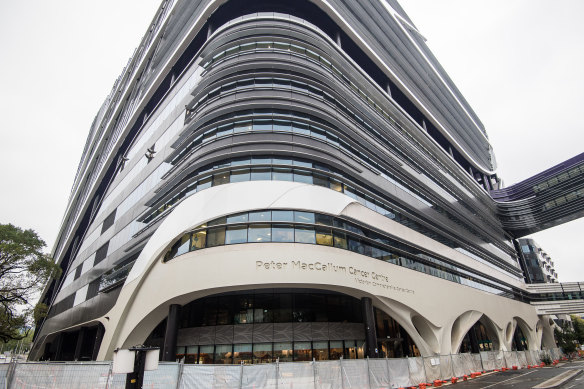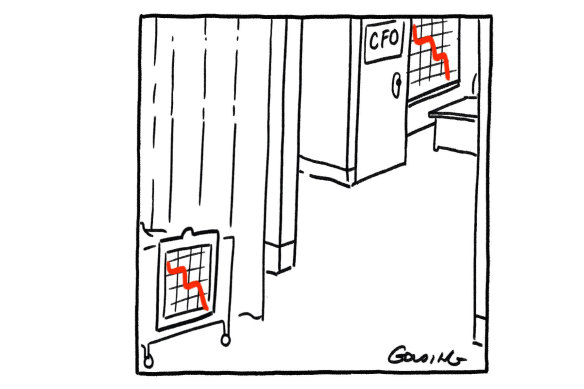$1b in red and going backwards: Victorian hospital cash-crunch revealed
By Broede Carmody, Rachel Eddie, Carla Jaeger and Kieran Rooney
A growing number of Victorian hospitals, including several of the largest Melbourne facilities, are cash-strapped and going backwards financially as they run operating losses and, in some cases, have less than one day’s money on hand to pay bills.
An analysis by The Age of 65 annual reports released in the Victorian parliament on Thursday found more than half the health services failed to meet the target number of days worth of cash available, measured on the final day of each month. Most had a target of 14 days and a total of 36 health services failed to hit their target.

The Peter MacCallum Cancer Centre.Credit: Justin McManus
Three Victorian hospitals did not have the necessary cash for their day-to-day work, while another two health services were left with less than a day’s worth of available funds in the last financial year.
Amid a drastic deterioration in financial health, the analysis also revealed that 44 services now had expenses outstripping their revenue as they racked up combined operating deficits of $906.546 million. Total operating deficits the previous year totalled just $460,000 as just eight facilities failed to break even.
Overall the 65 entities posted a total net operating loss of $881.179 million after the same facilities recorded a combined operating surplus a year earlier. Monash Health, one of the state’s largest providers, posted the largest operating deficit of $328.97 million.
On cash reserves, the worst performer was Goulburn Valley Health which, according to its latest annual report, had negative-seven days of cash at its disposal during the 2023-24 financial year. Just a year ago, the service comfortably surpassed its target with 36 days.
“GV Health was not able to deliver on its accountabilities in 2023-24 within its agreed budget,” the annual report said. It recorded an operating deficit of $38.38 million, blamed on the increasing costs of filling vacant positions with contract staff and a reduction in operating revenue.
Austin Health and Echuca Regional Health both had negative-two days of cash. Peninsula Health had zero days, while the Peter MacCallum Cancer Centre had less than half a day (0.48) of cash to spare.
A Peter MacCallum spokesperson said its cash reduction had no impact on patient care, and its reserves were topped up in July following funding provided for the new financial year. The hospital said there was a growing demand for cancer services, and that expenses had risen 22 per cent over the past two years because of rising costs, such as wage growth.
Peninsula Health CFO Rama Devarajan said it would continue to work with the Department of Health to address any cash concerns “well ahead of time”.

Goulburn Valley Health had an operating deficit of $38 million for 2023-24Credit: Kate Geraghty
Such cashflow shortages can force health services to pull funding from other areas to ensure they can still provide essential support. This can include not filling vacant positions – particularly non-clinical ones – as well as cutting spending on preventative health and stripping funding from training.
Dhelkaya Health’s annual report showed it had just one day of cash available. A year ago, Western Health had 56 days’ worth of cash to hand. Now it has two.
Monash Health, Northeast Health Wangaratta, West Gippsland Healthcare Group and Northern Health also each had about two days’ worth of cash available. Calvary Health Care had three.
Maryborough District Health Service, Hesse Rural Health Service, Omeo District Health, Bairnsdale Regional, Mansfield District Hospital, Eastern Health, Swan Hill District, Melbourne Health, La Trobe Regional Health, Alpine Health and Swan Hill District each had just four to five days.
The Royal Women’s, Grampians Health and Bendigo Health all said they had failed the targets but did not specify by how much.
The annual reports were published as part of a second “dump day” of documents tabled this financial year, a tradition in which the state government publishes a large number documents in just a few hours, leaving journalists little time to scrutinise them.
Last month’s dump day of annual reports revealed that more than a quarter of Victoria’s emergency patients were not being treated within the recommended time frames.
While the Department of Health’s annual report was published last month, a raft of annual reports for the state’s health services were delayed and published on Thursday.
In September, The Age revealed that Victoria’s health minister had sought an urgent $422 million cash bailout for the state’s hospitals last year so they could pay their staff and suppliers. In October, this masthead exposed how the budget-troubled Health Department was making late payments to suppliers more than half the time.
Australian Medical Association Victoria president Dr Jill Tomlinson said the results were a wake-up call.
“These figures show the challenges of keeping the lights on in our public health system at a time of record demand as Victorians get older, and their healthcare needs increase.”
Opposition health spokeswoman Georgie Crozier said Thursday’s annual reports showed the Allan government had found billions of dollars for the Suburban Rail Loop tunnel between Cheltenham and Box Hill, but was at risk of not paying doctors and nurses on time.

Victoria’s health minister sought an urgent $422 million cash bailout for the state’s hospitals last year.Credit: Matt Golding
“These reports reveal the extent of the cash crisis in our hospitals,” Crozier said. “Labor can’t manage money, can’t manage health, and it is Victorians who are paying the price.”
Health Minister Mary-Anne Thomas acknowledged on Thursday that more could be done to improve hospital budgets, but insisted that healthcare had not been compromised.
“The important issue here is that operating deficits have had no impact on the delivery of patient care,” Thomas said.
“We’ve established Hospitals Victoria, which is working closely with each of our health services to ensure that the money they receive, the investment that the government makes, is invested wisely.”
While the May budget tipped a record $13 billion into the public health system, hospitals were also told their future budgets would be locked in for the first time since the pandemic with no top-up spending.
But health insiders at the time warned the new rules could lead to bed closures, surgery delays and even the end of some breast screening and kidney dialysis services. One health service encouraged employees to turn off the lights when they exited a room to save money.
After a public backlash, the government in August dropped its plan to end future hospital bailouts, instead announcing an extra $1.5 billion in health funding. It prompted a missive from Treasurer Tim Pallas that funding could not keep flowing like it had.
Get the day’s breaking news, entertainment ideas and a long read to enjoy. Sign up to receive our Evening Edition newsletter.
correction
An earlier version of this story incorrectly stated that Central Highlands Rural Health had failed to meet its target by an unspecified amount. In fact it met its target by an unspecified amount. It also stated in a graphic that Tallangatta Health Service had an operating deficit of $69m. The figure was in fact $690,000.